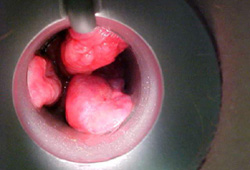Summary
Definition
History and exam
Key diagnostic factors
- rectal bleeding
- intermittent protrusion
- perianal pain/discomfort
Other diagnostic factors
- anal pruritus
- tender palpable perianal lesion
- anal mass
Risk factors
- age between 45-65 years
- constipation
- pregnancy or space-occupying pelvic lesion
- hepatic insufficiency
- ascites
Diagnostic tests
1st tests to order
- anoscopic exam
- colonoscopy/flexible sigmoidoscopy
- CBC
- stool for occult heme
Treatment algorithm
initial presentation: nonpregnant
initial presentation: pregnant
treatment failure of rubber band ligation, sclerotherapy, infrared coagulation, hemorrhoidal arterial ligation, or stapled hemorrhoidopexy
Contributors
Authors
Mohamed A. Thaha, PhD, FRCS (Gen Surg), PG Cert Hlt Econ
Senior Lecturer and Consultant in Colorectal Surgery
National Bowel Research Centre (NBRC)
Blizard Institute
Faculty of Medicine & Dentistry
Queen Mary University of London
Colorectal & Pelvic Floor Services
Royal London Hospital
Barts Health NHS Trust
London
UK
Disclosures
MAT declares that he has no competing interests.
Robert J.C. Steele, MD, FRCS
Professor of Surgery
Ninewells Hospital & Medical School
University of Dundee
Dundee
UK
Disclosures
RJCS declares that he has no competing interests.
Jayan Dewanta Jayasinghe, MD, FRCS (Gen Surg), FEBS (Coloproctology)
Senior Colorectal Fellow
Barts Health NHS Trust
Colorectal & Pelvic Floor Services
Royal London Hospital
London
UK
Disclosures
JDJ declares that he has no competing interests.
Acknowledgements
Mr Mohamed A. Thaha, Mr Jayan D. Jayasinghe, and Professor Robert J.C. Steele would like to gratefully acknowledge Dr Kurt G. Davis, the previous contributor to this topic.
Disclosures
KGD declares that he has no competing interests.
Peer reviewers
Tisha N. Lunsford, MD, FACG, AGA
Director of Motility
Mayo Clinic Arizona
Phoenix
AZ
Disclosures
TNL declares that she has no competing interests.
George Reese, MB BS MRCS
Honorary Clinical Research Fellow
Division of Surgery
Oncology
Reproductive Biology and Anaesthetics
Imperial College
St Mary's Hospital
London
UK
Disclosures
GR declares that he has no competing interests.
Alexander von Roon, MRCS
Clinical Research Fellow
Department of Biosurgery and Surgical Technology
Imperial College
St Mary's Hospital
London
UK
Disclosures
AVR declares that he has no competing interests.
Peer reviewer acknowledgements
BMJ Best Practice topics are updated on a rolling basis in line with developments in evidence and guidance. The peer reviewers listed here have reviewed the content at least once during the history of the topic.
Disclosures
Peer reviewer affiliations and disclosures pertain to the time of the review.
References
Key articles
Wald A, Bharucha AE, Limketkai B, et al. ACG clinical guidelines: management of benign anorectal disorders. Am J Gastroenterol. 2021 Oct 1;116(10):1987-2008.Full text Abstract
Hawkins AT, Davis BR, Bhama AR, et al. The American Society of Colon and Rectal Surgeons clinical practice guidelines for the management of hemorrhoids. Dis Colon Rectum. 2024 May 1;67(5):614-23.Full text
van Tol RR, Kleijnen J, Watson AJM, et al. European Society of Coloproctology: guideline for haemorrhoidal disease. Colorectal Dis. 2020 Jun;22(6):650-62. Abstract
Shanmugam V, Thaha MA, Rabindranath KS, et al. Rubber band ligation versus excisional haemorrhoidectomy for haemorrhoids. Cochrane Database Syst Rev. 2005 Jul 20;(3):CD005034.Full text Abstract
Reference articles
A full list of sources referenced in this topic is available to users with access to all of BMJ Best Practice.

Differentials
- Anal fissure
- Crohn disease
- Ulcerative colitis
More DifferentialsGuidelines
- The American Society of Colon and Rectal Surgeons clinical practice guidelines for the management of hemorrhoids
- Australian Department of Health pregnancy care guidelines: common conditions during pregnancy
More GuidelinesPatient information
Anal tears
Hemorrhoids
More Patient informationLog in or subscribe to access all of BMJ Best Practice
Use of this content is subject to our disclaimer

